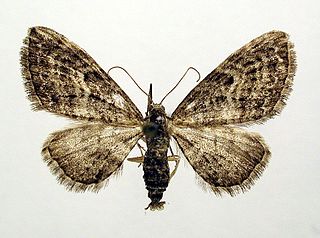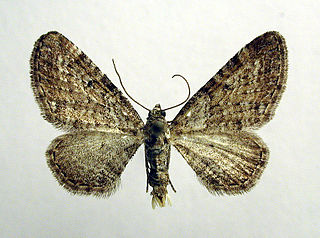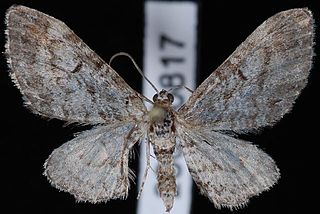
OclemenaE.L.Greene, is a small genus of North American flowering plants in the aster tribe within the.

Eupithecia is a large genus of moths of the family Geometridae. There are hundreds of described species, found in all parts of the world, and new species are discovered on a regular basis.

The lime-speck pug is a moth of the family Geometridae. It is a common species throughout the Palearctic region, the Near East and North Africa.

The common pug(Eupithecia vulgata) is a moth of the family Geometridae. It is a common species across the Palearctic region, the Near East and North Africa. It ranges from the Atlantic coast of Ireland and Portugal across Europe, the Middle East and Central Asia to the Russian Far East (Priamurje) and Korea.

The juniper pug or juniper looper(Eupithecia pusillata) is a moth of the family Geometridae. It is found throughout the Palearctic and Nearctic regions and the Near East.

The grove snail or brown-lipped snail is a species of air-breathing land snail, a terrestrial pulmonate gastropod mollusc. It is one of the most common species of land snail in Europe, and has been introduced to North America.

Poa nemoralis, the wood bluegrass, is a perennial plant in the family Poaceae. The late-growing grass is fairly nutritious for livestock, which feed on it in the autumn.
The elm cultivar Ulmus 'Nemoralis' was listed by Schelle in Beissner et al. (1903), as U. campestris f. nemoralisHort. Considered "possibly U. carpinifolia " by Green.

Eupithecia innotata, the angle-barred pug, is a moth of the family Geometridae. It ranges from Spain in the west to western Siberia and central Asia in the east.

The larch pug is a moth of the family Geometridae. The species can be found in Europe, the Ural Mountains, West and Central Siberia, the Altai Mountains, Transbaikalia, Yakutia, the Far East, Mongolia, Korea, Japan and in North America, from Yukon and Newfoundland to New York and Arizona.

Agrotera nemoralis, the beautiful pearl, is a species of moth of the family Crambidae. It was first described by Giovanni Antonio Scopoli in his 1763 Entomologia Carniolica.

Eupithecia simpliciata, the plain pug, is a moth of the family Geometridae. It is found in the Palearctic ecozone, from western Europe to north-western China (Xinjiang).

Solidago nemoralis is a species of flowering plant in the aster family, Asteraceae. It is native to North America, where it is widely found in Canada and the United States. Its common names include gray goldenrod, gray-stem goldenrod, old-field goldenrod, field goldenrod, prairie goldenrod, dwarf goldenrod, and dyersweed goldenrod.

Eupithecia venosata, the netted pug, is a moth of the family Geometridae. It was first described by Johan Christian Fabricius in 1787. It is found across the Palearctic ecozone from Portugal and Morocco in the west to the Lake Baikal in Siberia and Afghanistan and Pakistan in the east.

Phacelia nemoralis is a species of flowering plant in the borage family known by the common name shade phacelia. It is native to the west coast of the United States from Washington to central California, where it grows in moist, usually forested areas along the coastline and in the coastal mountain ranges.

Eupithecia pernotata, or Guenée's pug, is a moth of the family Geometridae. The species was first described by Achille Guenée in 1857. It is known from the Alps, through Romania to southern Russia. It is also found in Finland.
Eupithecia variostrigata is a moth in the family Geometridae. It is widespread in the western Palaearctic, ranging from Spain to the western Pamirs in the east.

Eupithecia silenicolata is a moth in the family Geometridae. It is found from southern Europe and Morocco to western Asia, Iran and Pakistan. In the north, the range extends to southern Switzerland, Austria and northern Italy.

Eupithecia graefi, or Graef's pug, is a moth in the family Geometridae. The species was first described by George Duryea Hulst in 1896. It is found in North America from south-western Alberta west to Vancouver Island, north to Alaska and south to California. The habitat consists of wooded areas.


















